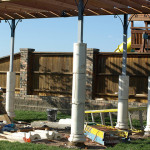cost
–noun
1. the price paid to acquire, produce, accomplish, or maintain anything: the high cost of a good meal.
2. an outlay or expenditure of money, time, labor, trouble, etc.: What will the cost be to me?
The Problem
Even though this IS the avoidable alphabet, cost isn’t something to necessarily avoid, as much as it is to be careful of. Cost has many variables attached to it, but for now we’ll focus on three of them: value, quality and sacrifice. Cost, in case you didn’t notice, is also a four-letter word. Yup, one of THOSE four-letter words. But it doesn’t have to be, and I’m here to explain the why’s and how’s.
Let’s go back to those three words I mentioned above, starting with value. Ask yourself, ‘Am I adding value to my property by implementing my vision?’, or ‘Will the finished product be worth more to me than what I paid for it?’ (you’ll see these questions repeated in a future post that highlights one of my favorite new books about effective business practices. It’s called ‘The Go-Giver’, and I suggest you read it yesterday…)But for now, these first questions will help gauge the level of value you’re about to receive.
 Next is quality. Out of all the bids and proposals and cost-estimates and concepts and materials and plants and designers and… Out of everything you’ve seen and touched and heard in the process leading up to the point where you sign on the dotted line and fork over that deposit check, are you certain that you’re choosing the option that provides for you the highest quality? Are you comfortable in the choice(s) you made for the money you saved if the answer was ‘no’? That’s fine if you are, but you’ll rethink your priorities in 15 months when that wall collapses, those plants die or that sprinkler head fails. Unfortunately, homeowners sometimes only see the bottom line, especially in a slow economy. But beware, the low-bidder may be the low-bidder because they are sacrificing quality.
Next is quality. Out of all the bids and proposals and cost-estimates and concepts and materials and plants and designers and… Out of everything you’ve seen and touched and heard in the process leading up to the point where you sign on the dotted line and fork over that deposit check, are you certain that you’re choosing the option that provides for you the highest quality? Are you comfortable in the choice(s) you made for the money you saved if the answer was ‘no’? That’s fine if you are, but you’ll rethink your priorities in 15 months when that wall collapses, those plants die or that sprinkler head fails. Unfortunately, homeowners sometimes only see the bottom line, especially in a slow economy. But beware, the low-bidder may be the low-bidder because they are sacrificing quality.
 Finally, we look at sacrifice (see: definition 3). In regards to your new backyard oasis, sacrifice refers to money and time. Is the finished product worth the time you sacrificed to earn the amount of money you spent on the cost? Another way of looking at this is the relation between the initial sacrifice in time from above compared to the additional time you’re rewarded through enjoyment of your new environment at it’s completion, and maybe even additional money earned through resale. This is precisely why every real-estate agent will tell you that curb-appeal is one of the three elements that should be upgraded before selling a house, in order to gain the highest resale VALUE (kitchen and bathroom(s) are the other two). Notice how we’re already back to value? What tangled webs we weave…
Finally, we look at sacrifice (see: definition 3). In regards to your new backyard oasis, sacrifice refers to money and time. Is the finished product worth the time you sacrificed to earn the amount of money you spent on the cost? Another way of looking at this is the relation between the initial sacrifice in time from above compared to the additional time you’re rewarded through enjoyment of your new environment at it’s completion, and maybe even additional money earned through resale. This is precisely why every real-estate agent will tell you that curb-appeal is one of the three elements that should be upgraded before selling a house, in order to gain the highest resale VALUE (kitchen and bathroom(s) are the other two). Notice how we’re already back to value? What tangled webs we weave…
The Solution
So, now that I’ve scared the living crap outta you, you want to know what to do to make sound decisions? Well, the best ways to maximize all you want without giving up all you have, is to be patient, be realistic and use your resources. Let me explain.
 As they say, ‘patience is a virtue.’ And renovating your landscape is no different than any other situation when it comes to being patient. Unless you’re hosting a graduation party at your house in, like, 3 weeks, you shouldn’t be in a hurry. Your Memorial Day or Fourth of July party is NOT an excuse for you to have a sense of urgency. Those things happen every year. And that graduation party could occur at any number of pretty cool venues for not a lot of money (but if you plan enough in advance, you can have your cake and eat it too, right in your very own NEW back yard!). This is because even the smallest of projects take time to plan and implement. Allowing these processes to happen at a normal pace will save you money, but most importantly, patience will save you, the designer and the contractor(s) a lot of aggravation. Patience may also save everyone time in the end, as rushed planning and construction can lead to mistakes, which then requires extra time to fix. Nothing is more embarrassing than having a partially done landscape, or one that looks rushed and full of mistakes, during that meant-to-impress occasion. In fact, it’s almost tacky. And you don’t want that, and we don’t want that for you. Besides, if you are planning and renovating for one specific occasion, you probably have enough other things on your mind and schedule. The last thing you’d want to do is to be dancing around construction debris and equipment when planning for li’l Debbie’s sweet sixteen. So plan for your renovation or addition well in advance so you can allow yourself to be patient during the process.
As they say, ‘patience is a virtue.’ And renovating your landscape is no different than any other situation when it comes to being patient. Unless you’re hosting a graduation party at your house in, like, 3 weeks, you shouldn’t be in a hurry. Your Memorial Day or Fourth of July party is NOT an excuse for you to have a sense of urgency. Those things happen every year. And that graduation party could occur at any number of pretty cool venues for not a lot of money (but if you plan enough in advance, you can have your cake and eat it too, right in your very own NEW back yard!). This is because even the smallest of projects take time to plan and implement. Allowing these processes to happen at a normal pace will save you money, but most importantly, patience will save you, the designer and the contractor(s) a lot of aggravation. Patience may also save everyone time in the end, as rushed planning and construction can lead to mistakes, which then requires extra time to fix. Nothing is more embarrassing than having a partially done landscape, or one that looks rushed and full of mistakes, during that meant-to-impress occasion. In fact, it’s almost tacky. And you don’t want that, and we don’t want that for you. Besides, if you are planning and renovating for one specific occasion, you probably have enough other things on your mind and schedule. The last thing you’d want to do is to be dancing around construction debris and equipment when planning for li’l Debbie’s sweet sixteen. So plan for your renovation or addition well in advance so you can allow yourself to be patient during the process.
 While flipping through magazines of beautiful backyard pictures or imagining your new oasis in your own mind, one tends to have very grand ideas. This can be a very dangerous (and costly) endeavor. It’s very easy to have champagne taste, but only a beer budget, as just about everything will probably cost more than you had hoped. Be realistic about what elements to include in your landscape project by creating a priority list. This is especially important for homeowners with small sites. It’s very difficult to fit ten pounds of grain into a five pound sack.
While flipping through magazines of beautiful backyard pictures or imagining your new oasis in your own mind, one tends to have very grand ideas. This can be a very dangerous (and costly) endeavor. It’s very easy to have champagne taste, but only a beer budget, as just about everything will probably cost more than you had hoped. Be realistic about what elements to include in your landscape project by creating a priority list. This is especially important for homeowners with small sites. It’s very difficult to fit ten pounds of grain into a five pound sack.
And lastly, but certainly not least, use the resources you have available. Part of being patient and realistic is gong to places like stone yards, plant nurseries or even web pages to collect information regarding cost, availability and practical application. Let me tell you, an educated homeowner is a treat to work with as a designer and builder. This point is also relevant when selecting the company that will design and/or build your new environment.
You may tend to gravitate towards the low bidder, especially in a sluggish economy. But beware, these lower prices may be reflected in the quality of materials or workmanship. Don’t get fooled by companies that can ‘promise you the world’ for a lot cheaper than their competitors. The outcome will probably parallel the cost, and that isn’t a good thing. Some cheaper materials can be used when they’re not part of the focal point or highlight of the entire project. But you should always involve yourself in the selection of EVERY material used that makes up the finished appearance (but, there’s no need to help decide which type of gravel will be used as base material for the patio, though.). This ensures that you get the same product or model that you discussed in the planning phase, and if there is an issue with availability, you have the knowledge to select an alternative.
On the flip side, don’t get tricked in to overpaying for your project either. You may also feel that the expensive company will give you the best product. This may also be misleading as you may be paying way too much for materials that are unnecessary or are astronomically marked-up. There is usually more than one way or product to create an element in your project, be it a grill island, a fire place or even a simple retaining wall. It’s not necessary to use granite for a wall if it is going to be painted anyway. A good rule to follow is: if you won’t see it upon completion, go with the cheaper of the options. The contractor may still try to convince you otherwise, but a little internet research can provide useful information to aid in your decision.
These days, it’s very easy to see a company’s body of work or obtain a referral online. Some companies (like Square Root Design Studio, for example) will provide their prospective clients with a complete digital portfolio and list of references upon request. By using your resources, you should be able to avoid paying too much or too little.
Remember, it’s not just your money, it’s your investment, but you’ll always get what you pay for. Be smart with it so you may it provide enjoyment for yourself and your family and friends for many years to come. This will ensure that you’re getting excellent value and high quality that makes your sacrifice worth while.
See you soon..
image credits: elycefeliz, Stacy Lynn Baum, Jason Permenter, emptyhighway, stëve, stirlingstoneworks, Daniele Muscetta


Recent Comments